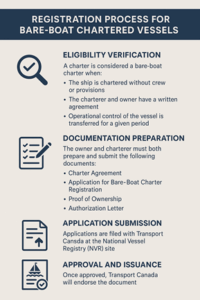Bare-Boat Chartered Vessels in the Canadian context represent a type of vessel registration and operation. A vessel on a bare boat charter is placed under the supervision and control of an entity while the legal title remains that of the owner. The charterer is responsible for crewing, maintenance, and navigation.
Bare-boat, or demise, charters are commonly used in the commercial and private sectors. The main advantage is the flexibility of ship ownership. Bare-boat charters constitute a vital part of the chartering business in Canada to manage expenses, or to meet international business demands, which is essential for compliant ship ownership.
What Are Bare-Boat Chartered Vessels and Why They Matter
A Bare-Boat Chartered Vessel is a vessel on which the charterer has use of the vessel without crew, fuel, or provisions. The owner, in this case the titled owner, simply delegates the management to the charterer.
| Aspect | Vessel Owner | Bare-Boat Charterer |
|---|---|---|
| Ownership | Retained | None |
| Operation Control | Delegated | Full authority |
| Crew & Maintenance | Not provided | Fully responsible |
| Insurance & Safety | Owner oversight | Charterer assumes risk |
| Registry Responsibility | May change temporarily | Subject to approval |
Importance of Bare-Boat Chartering in Maritime Industry
- Operational Flexibility: Charterers can use vessels without purchasing them.
- Cost Efficiency: Allows for fleet capacity without capital expenditure.
- International Expansion: Temporary reflagging of international routes.
- Compliance Assurance: Registered affiliate of Transport Canada for accountability.
Registration Process for Bare-Boat Chartered Vessels
Registration allows the chartered vessel to be operated legally in Canada or in a foreign registry.

Eligibility Verification
A charter is considered a bare-boat charter when:
- The ship is chartered without crew or provisions.
- The charterer and owner have a written agreement.
- Operational control of the vessel is transferred for a given period.
Documentation Preparation
The owner and charterer must both prepare and submit the following documents:
- Charter Agreement (duration, responsibilities, and insurance requirements).
- Application for Bare-Boat Charter Registration.
- Proof of Ownership (from the registered owner).
- Authorization Letter allowing charter registration.
- Certificate of Registry or similar document.
Application Submission
Applications are filed with Transport Canada at the NVRC site, and the vessel itself can be registered in Canada for domestic chartering, or registered under foreign flag for international operations.
Approval and Issuance
Once this is done, Transport Canada will certify that the vessel is on a bare-boat charter and is allowed to fly a non-Canadian flag temporarily or conditionally.
Compliance Maintenance
Charterers must maintain:
- Valid certificates or licenses.
- Comply with maritime safety and environmental laws of.
- Notifications of renewal or termination upon charter completion.
It makes sure all parties are accountable and compliant during the charter’s term.
Legal and Operational Framework
The Canadian bare-boat charter system operates under several Acts and conventions under maritime law.
Regulatory Authority
Transport Canada regulates chartering and registration of bare-boats, under the Canada Shipping Act, 2001 and also approves charter terms and registry recognition.
Dual Registration Prohibition
A vessel cannot hold full registration under two national registries, but its Canadian registry may approve bare-boat chartering under a foreign flag.
Safety and Insurance Obligations
Under these charters, the charterer is responsible for the condition of the boat, insurance and safety.
International Operations
In a bare-boat charter, the flag state’s laws apply to the vessel during its temporary registration.
Responsibility Owner Charterer
- Title of Ownership Maintained None
- Operational Command None Full
- Maintenance & Crew Not responsible Mandatory
- Legal Liability Limited Primary
Bare-Boat Charter vs. Time Charter vs. Voyage Charter

- Bare-Boat Charter provides full operational control to the charterer (100%).
- Time Charter offers partial operational control (60%).
- Voyage Charter has the lowest operational control level (40%).
- The level of operational control decreases progressively from Bare-Boat to Voyage Charter.
Practical Considerations for Bare-Boat Charter Agreements
Clear Legal Agreement
The agreement must specify:
- Length of the charter period.
- Have responsibility for maintenance and operation.
- Insurance and liability clauses.
- Steps to renew or end.
Vessel Inspection
The vessel owner or operator should check the vessel for compliance with Transport Canada standards and insurance before the charter begins.
Crew Certification
The charterer supplies and appoints the crew yet they all must hold Canadian maritime certification.
Insurance Coverage
The owner and the charterer will get insurance for property risks, liability risks, and pollution risks.
Termination and Re-registration
When the charter period ends, the ship will return under its original registry, thus avoiding any duplication of authority.
Stage Responsible Party Action
- Before Charter: Owner & Charterer must execute agreement & determine eligibility.
- During Charter: Charterer – Maintain operation and compliance
- After Charter: Owner – Resume registry and operational control
Bare-Boat Chartering for Coastal Research
Because a Canadian environmental organization wanted to use a research ship without buying or leasing one, it agreed to a bare-boat charter on an 18-month contract for a government-registered research vessel.
Steps Taken:
- The formal charter agreement was signed.
- Registered under Canadian bare-boat charter authorization.
- Managed crew, equipment, and compliance independently.
Outcome:
This allowed the organization to do relatively large-scale research, which was completely legal and safe. This is an example where bare-boat charters are available with a measure of freedom under regulation.
Best Practices for Managing Bare-Boat Chartered Vessels
- Make legal aspects clear: Create agreements that detail duties and rights.
- Verify Registry Details: Check the validity of the registry.
- Maintain Insurance Compliance: Each party must maintain sufficient insurance coverage at all times within.
- Conduct Regular Audits: Periodically audit your vessel for safety and regulatory compliance.
| Scenario | Key Requirement | FAA / Regulatory Action | Owner Responsibility / Benefit |
|---|---|---|---|
| Export | Detailed Agreement | De-register and provide new registry details | Prevents legal disputes by defining transfer terms clearly. |
| Accident | Proper Insurance | Record and confirm loss | Protects both owner and charterer from financial liabilities. |
| Company Merger | Updated Registration | Update ownership documentation | Ensures operational legitimacy under the new entity. |
| Donation | Regular Inspection | De-register under donor’s name | Maintains safety and reliability during and after transfer. |
Why Bare-Boat Chartered Vessels Are Vital for Maritime Flexibility
In summary, National Vessel Registry Center provide an effective process for charterers to operate the ship competitively and flexibly. The owner has no financial risk, yet maintains the value of the asset, and the charterers have complete control to pursue commercial, scientific or private objectives.
Compliance with Transport Canada’s modernized Canadian registry, accurate registration and a quality documentation trail by ownership and chartering parties achieves operational and legal certainty.

